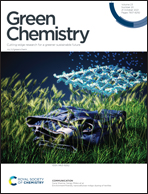A carboxymethylcellulose-mediated aqueous colloidal process for building plasmonic–excitonic supramolecular nanoarchitectures based on gold nanoparticles/ZnS quantum emitters for cancer theranostics†
Abstract
Despite indisputable advances in recent years, glioblastoma multiforme (GBM) remains one of the most lethal types of brain cancers. Hybrid matter-based nanostructures have exceptional potential as a multimodal tool against GBM by amalgamating the earliest possible diagnosis with options of therapy termed nanotheranostics. Thus, in this research, we report for the first time the rational design and synthesis of novel plasmonic–excitonic nanohybrids produced based on a green nanomedicine approach using a carboxymethylcellulose (CMC) multifunctional biopolymer acting simultaneously as a capping ligand and biocompatible shell through an eco-friendly aqueous colloidal process for nanotheranostics of brain cancer cells. These nanohybrids comprised of gold nanoparticles (AuNPs) coupled to a layer of ZnS semiconductor quantum emitter (ZnS-QE) surrounded by the CMC macromolecular shell (AuNP-ZnS@CMC), which displayed water-dispersed colloidal supramolecular nanoarchitectures stabilized by the polysaccharide chemical functional groups. They demonstrated nanotheranostic behavior by concurrently integrating the excitonic activity of the ZnS-QE layer for fluorescence bioimaging with the plasmonic properties of AuNPs for effectively killing GBM cancer cells in vitro. Hence, it can be anticipated that this hybrid nanoplatform could pave the way for the development of advanced multifunctional green nanomedicine against cancer through an environmentally sustainable strategy.



 Please wait while we load your content...
Please wait while we load your content...